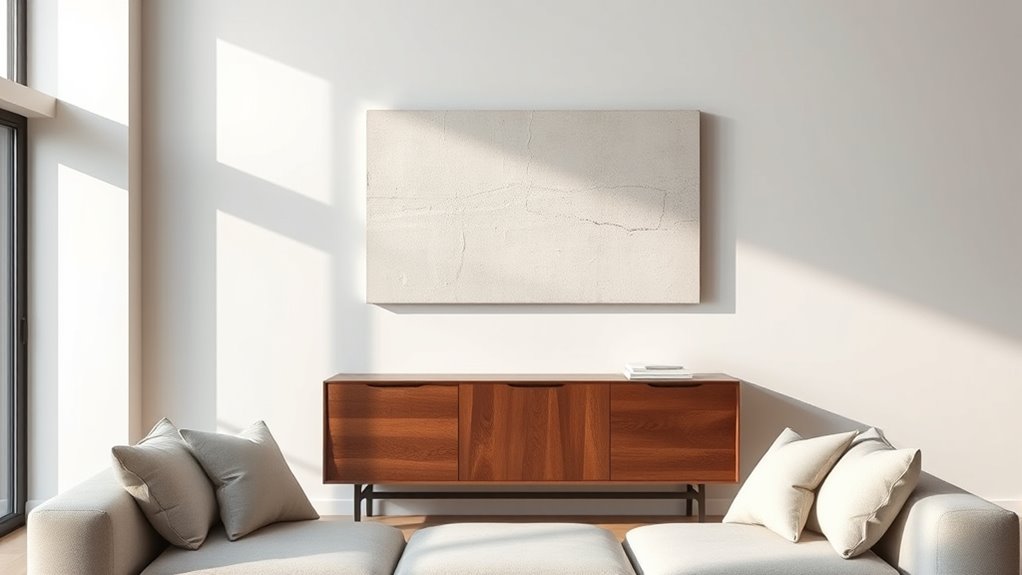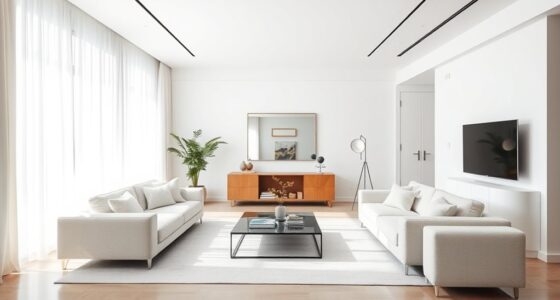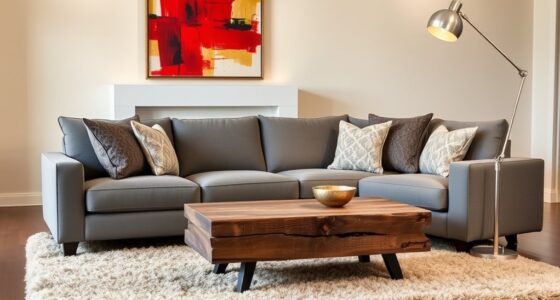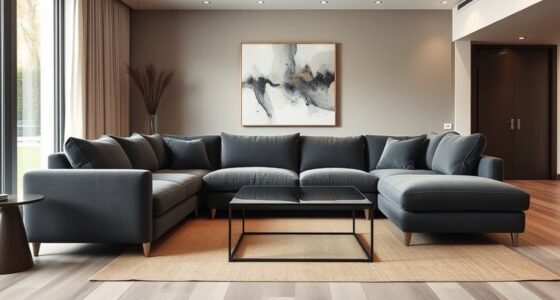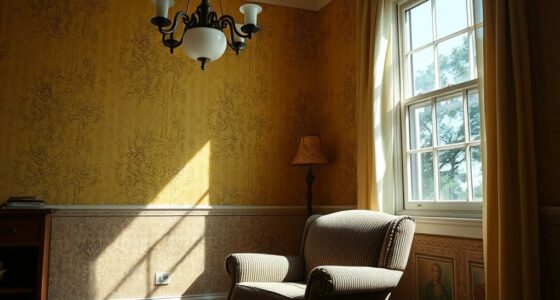The wall art hanging height that designers always follow is keeping the artwork’s center approximately 57-60 inches from the floor at eye level. This standard creates a balanced, visually pleasing display. You should also consider the size of your artwork, furniture placement, and ceiling height for the best results. By sticking to these guidelines, you’ll achieve a harmonious look—continue exploring for tips on perfecting your art arrangement.
Key Takeaways
- Hang artwork with the center approximately 57-60 inches from the floor, aligning with the standard eye-level rule.
- Adjust the height based on furniture placement, room function, and ceiling height for optimal visual balance.
- For multi-piece displays, maintain consistent spacing and align centers to create a cohesive look.
- Use proportional guidelines like the golden ratio to position art along natural sightlines.
- Consider wall material and size of artwork to ensure proper placement that enhances room aesthetics.
The Standard Eye-Level Rule
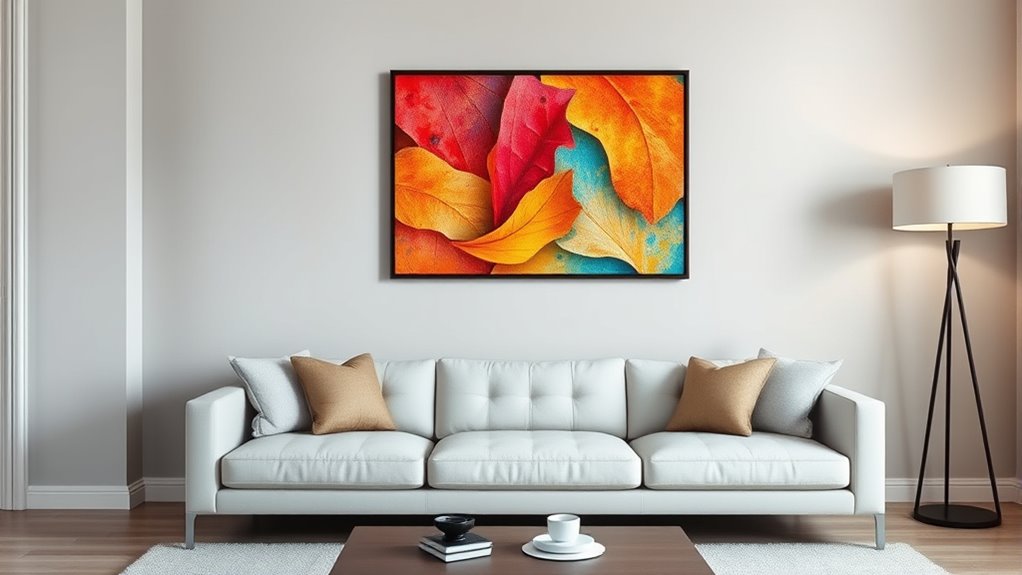
The standard eye-level rule is a simple guideline that helps guarantee your wall art looks balanced and visually appealing. Typically, you should hang artwork so that its center is about 57 to 60 inches from the floor, which aligns with the average eye level. This approach ensures your art feels natural and engaging without overwhelming or disappearing against the wall. When you follow this rule, it creates a cohesive look, especially in rooms with furniture like sofas or dining tables. Keep in mind, this is a flexible guideline—adjust it slightly depending on ceiling height or the artwork’s size. Sticking close to eye level makes sure your art draws attention and complements your space effortlessly.
Measuring From the Center of the Artwork
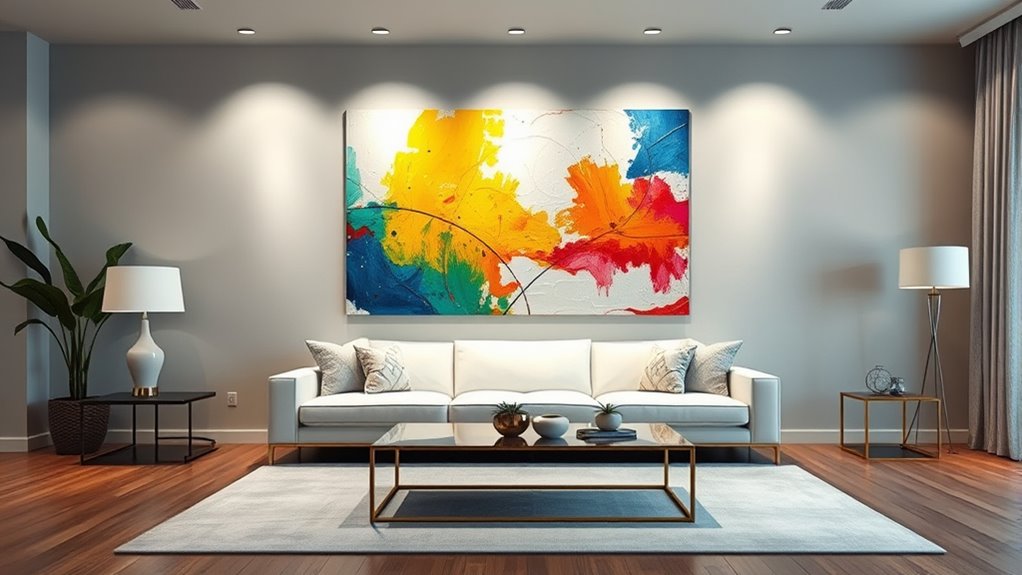
To accurately hang your artwork, start by measuring from its center point rather than just the top or bottom. This guarantees your piece is level and visually balanced. First, find the midpoint of your artwork by measuring its height and dividing by two. Mark this center point. Next, determine the desired hanging height on your wall and mark it. Measure from that mark to the center point of your art to find the right hanging wire or hardware placement. Here’s a quick reference:
| Artwork Height | Center Point | Hanging Mark |
|---|---|---|
| 24 inches | 12 inches | 10 inches |
| 36 inches | 18 inches | 16 inches |
| 48 inches | 24 inches | 22 inches |
This method guarantees your art hangs perfectly at eye level. Additionally, considering the safe sleep environment for your space can help create a comfortable ambiance for your home. Incorporating appropriate lighting, such as ambient and task lighting, can enhance the overall warmth and coziness of your farmhouse bedroom.
Accounting for Furniture Placement
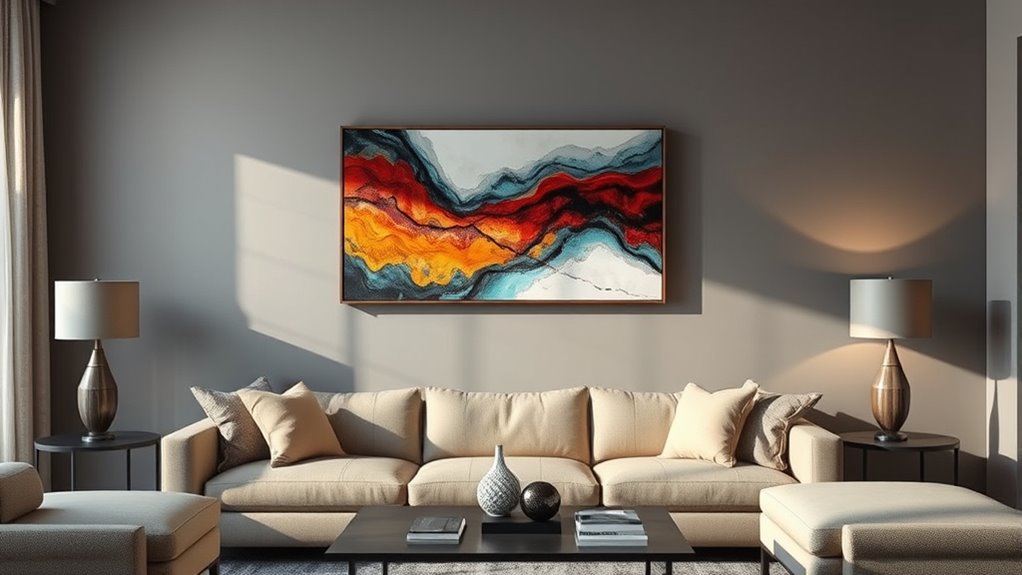
When hanging art, consider how your furniture interacts with the pieces to create balance and harmony. Align artwork with eye level and think about the room’s purpose to guarantee the arrangement feels natural. Taking these factors into account helps your decor look intentional and well-coordinated. Incorporating some vertical storage solutions can also help optimize space and maintain a clutter-free environment, enhancing the overall aesthetic. Additionally, understanding furniture placement can influence how you select and position your artwork for a cohesive look. Ensuring your art complements existing elements can also prevent visual clutter and improve the room’s overall flow.
Balance With Furniture
Achieving visual harmony involves considering how your wall art interacts with nearby furniture. You want your artwork to complement rather than compete with pieces like sofas, tables, or cabinets. To do this, think about the size of your furniture; larger pieces may need larger or more prominent artwork, while smaller furniture benefits from more subtle pieces. Position your art so it feels balanced in relation to the furniture’s scale and placement. For example, a large sofa pairs well with a sizable piece above it, maintaining visual weight. Conversely, if your furniture is low or minimal, opt for smaller artwork to avoid overwhelming the space. Ultimately, your goal is to create a cohesive look where the art enhances the furniture, not distract from it.
Eye-Level Alignment
Since furniture placement influences how people naturally view wall art, aligning your artwork at eye level helps create a balanced and inviting space. When you hang art at this height, it becomes the focal point without overwhelming furniture or clutter. Consider the typical eye level, about 57-60 inches from the floor, to achieve harmony. Visualize this placement with the following:
| Furniture Type | Ideal Artwork Position |
|---|---|
| Sofa or Couch | Centered above, with the bottom 6-12 inches below eye level |
| Dining Table or Sideboard | Slightly higher, but still at eye level for comfort |
| Bed Headboard | Artwork should sit slightly above the headboard |
| Armchair or Reading Nook | At eye level when seated, not standing |
This alignment ensures your wall art complements your furniture seamlessly.
Room Function Considerations
Room function plays a key role in determining the best placement for wall art. For example, in living rooms, hang artwork at eye level so it complements sofas and seating areas, creating a balanced visual flow. In bedrooms, consider the bed’s height; artwork should be placed so it’s visible from a lying position without overwhelming the space. Dining rooms benefit from art above sideboards or buffets, where it can be appreciated without interfering with table use. For home offices, hang pieces where they won’t distract or block natural light. Always consider furniture placement to ensure art enhances functionality and aesthetics. Properly positioned artwork not only elevates your space but also enhances comfort and usability based on how you use each room. Additionally, understanding camping essentials can inspire outdoor-themed decor that complements your interior design. When planning your wall art, keep in mind the importance of security zone info to prevent potential damage or theft of valuable pieces. Furthermore, coordinating wall art with lighting considerations can highlight its details and create a more inviting atmosphere. Paying attention to ambient light levels can also help maintain the artwork’s appearance over time and prevent fading. Incorporating appropriate art height guidelines ensures visual harmony and a cohesive room design.
Considering Ceiling Height and Room Scale
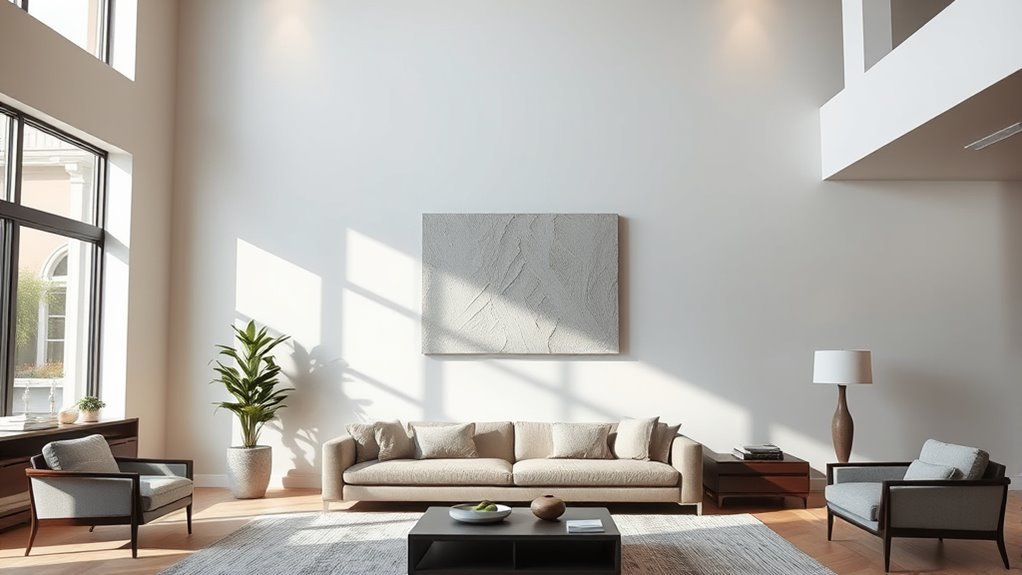
When hanging wall art, you need to take into account the room’s ceiling height and overall scale to create a balanced look. Proportional wall space ensures your artwork fits well without overwhelming or getting lost, while ceiling height influences whether you opt for eye-level placement or taller pieces. Achieving room scale harmony means choosing art that complements the space’s size, making everything feel cohesive and inviting. Additionally, understanding cultural narratives and design trends can help guide your choices to enhance the room’s aesthetic impact. Incorporating unique and wicked planters as part of your decor can also add a creative touch to the overall aesthetic. Considering digital distractions when selecting artwork can help create a calming environment that fosters focus and creativity. Recognizing how attention influences creative practice can also inspire you to design spaces that promote mindfulness and concentration. Moreover, applying insights from personality traits can assist in selecting art that resonates with your personal style and emotional needs.
Proportional Wall Space
Achieving the right proportion between wall art and the surrounding space enhances the overall harmony of a room. You want your artwork to complement the room’s scale without overwhelming or appearing too small. Consider the wall area where you plan to hang the piece; a large piece works best on a spacious wall, while smaller art suits more confined spaces. Leave enough space around the artwork so it doesn’t feel crowded, but ensure it’s not so isolated that it looks disconnected. Think about the room’s furniture and how the art relates to it—aim for a visual balance that feels natural. By paying attention to proportional wall space, you create a cohesive look that elevates your room’s style and makes the artwork feel intentional.
Ceiling Height Balance
Ceiling height plays a crucial role in determining the ideal placement of your wall art, as it influences the overall balance and visual flow of the space. In rooms with higher ceilings, you can hang artwork higher to avoid overwhelming the walls, creating a sense of openness. Conversely, in rooms with lower ceilings, placing art slightly lower helps prevent the space from feeling cramped or top-heavy. Consider the room’s scale; taller ceilings often call for larger, more dramatic pieces to fill the vertical space effectively. You want your art to complement the ceiling height, not compete with it. Striking the right balance ensures your artwork enhances the room’s proportions and creates a cohesive, inviting atmosphere. Additionally, understanding art placement and proper hanging techniques can help you create a harmonious environment that reflects both style and functionality. Paying attention to lighting can also enhance the visual impact of your wall art and further balance the space. Proper wall decor arrangement also considers the viewer’s eye level and how the artwork interacts with other elements in the room, ensuring a well-proportioned and aesthetically pleasing setup. Being mindful of furniture scale can further improve the overall harmony between your wall art and the room’s furnishings.
Room Scale Harmony
Balancing room scale with ceiling height guarantees your wall art feels integrated and proportionate. When your artwork matches the room’s size, it creates a cohesive look that enhances your space. Consider how larger rooms can handle bigger pieces, while smaller rooms benefit from more delicate, scaled-down art. To help visualize, here’s a quick guide:
| Room Size | Art Scale | Hanging Height |
|---|---|---|
| Small | Smaller, subtle pieces | Slightly above eye level |
| Medium | Moderate-sized artwork | Centered at eye level |
| Large | Oversized art | Lower or higher for drama |
Proper wall art placement is essential for creating a balanced and inviting atmosphere. Additionally, considering room scale harmony can further enhance the visual cohesion of your space. Incorporating lighting techniques can also highlight your artwork and improve overall room balance. Paying attention to art proportion can help ensure your display feels intentional and well-curated. Moreover, understanding how cybersecurity vulnerabilities can impact digital art displays is increasingly important in modern interior setups.
The Golden Ratio in Wall Art Placement
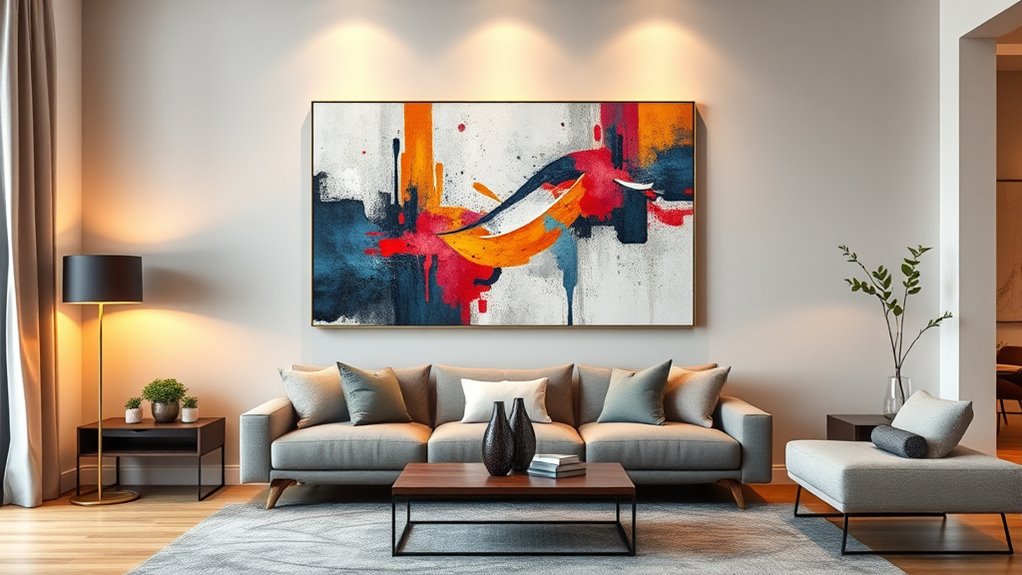
The Golden Ratio offers a timeless guideline for creating visually pleasing wall art arrangements, guiding you to place pieces where they naturally catch the eye. When you incorporate this ratio, your artwork feels balanced and harmonious. To apply it effectively:
- Divide your wall into sections based on the ratio, placing key pieces along these lines.
- Position your focal point at the intersection of these lines to draw attention.
- Use the ratio to determine the ideal height, aligning the center of your art with the “sweet spot.”
- Create a visual flow by arranging multiple pieces so they follow the natural eye movement inspired by the ratio.
- Remember that visual balance is key to achieving an aesthetically pleasing display that feels both natural and intentional.
Following these steps helps your wall art feel intentional, balanced, and effortlessly mesmerizing.
Adjusting for Different Wall Types
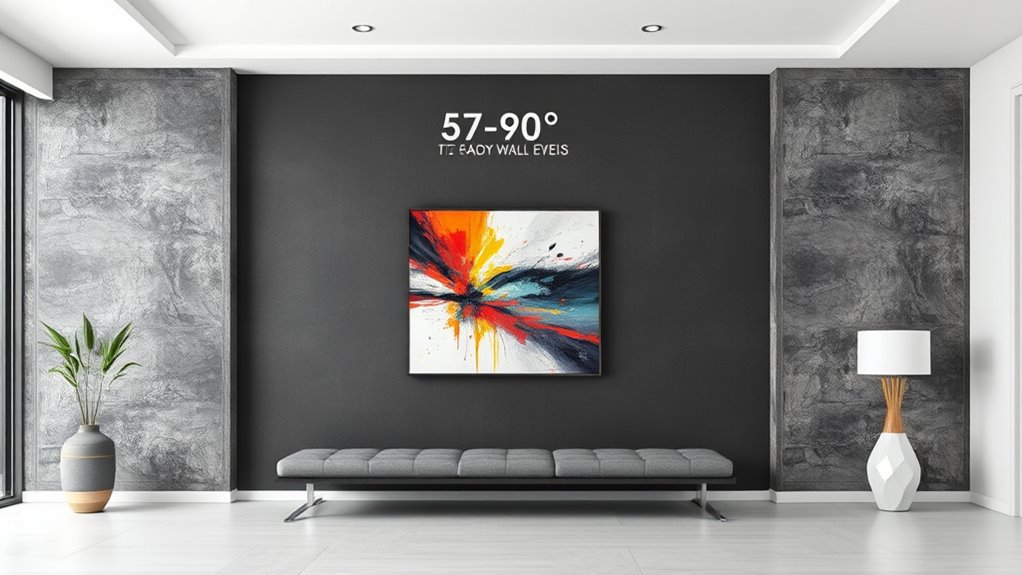
Different wall types can substantially influence how you should hang your artwork to achieve ideal visual impact. If you’re dealing with textured or uneven walls, opt for lighter frames or use picture-hanging strips to prevent damage and guarantee stability. For brick or stone walls, you might need special anchors or masonry nails to secure your art properly. Drywall allows for more flexibility; you can use standard hooks or nails, but always consider wall weight and artwork size. If your wall has a high gloss or reflective surface, hang art slightly higher to avoid glare and maintain visibility. Adjust your hanging height based on the wall’s material to prevent damage and optimize the artwork’s appearance. Tailoring your approach ensures your art looks polished and well-placed, regardless of wall type. Additionally, understanding the environmental considerations can help you select appropriate hanging methods that minimize impact on your space.
Creating Visual Balance With Multiple Pieces
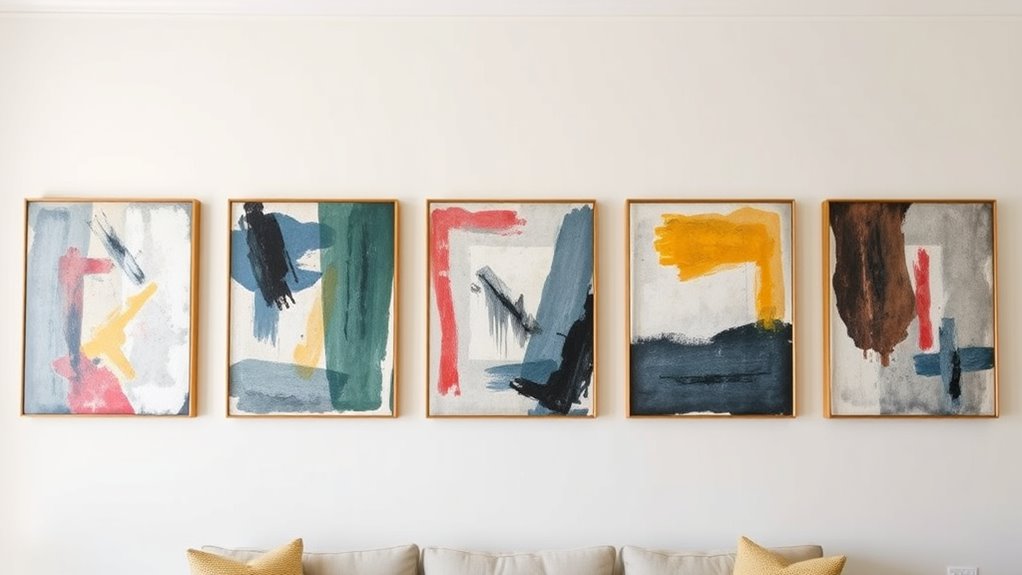
When arranging multiple pieces of wall art, creating a cohesive and visually appealing display requires careful planning. To achieve balance, consider these key tips:
- Maintain consistent spacing between pieces to create harmony.
- Align the centers of your artwork at a common height for unity.
- Vary sizes intentionally to add interest without cluttering.
- Create a visual anchor by positioning the largest piece first, then arrange smaller ones around it.
Tips for Hanging Art in High or Low Ceilings

Hanging art in rooms with high or low ceilings requires adjusting your approach to guarantee your displays look balanced and proportionate. For rooms with high ceilings, consider hanging artwork slightly lower than usual to create a sense of intimacy and prevent the art from feeling lost. You can also group multiple pieces or use larger artwork to fill vertical space effectively. In rooms with low ceilings, hang art slightly higher than eye level to open up the space and create the illusion of height. Avoid placing artwork too low, which can make ceilings feel even shorter. Whichever ceiling height you have, keep a consistent visual line for the artwork’s center, ensuring it complements the room’s proportions and maintains harmony.
Common Mistakes to Avoid When Hanging Art
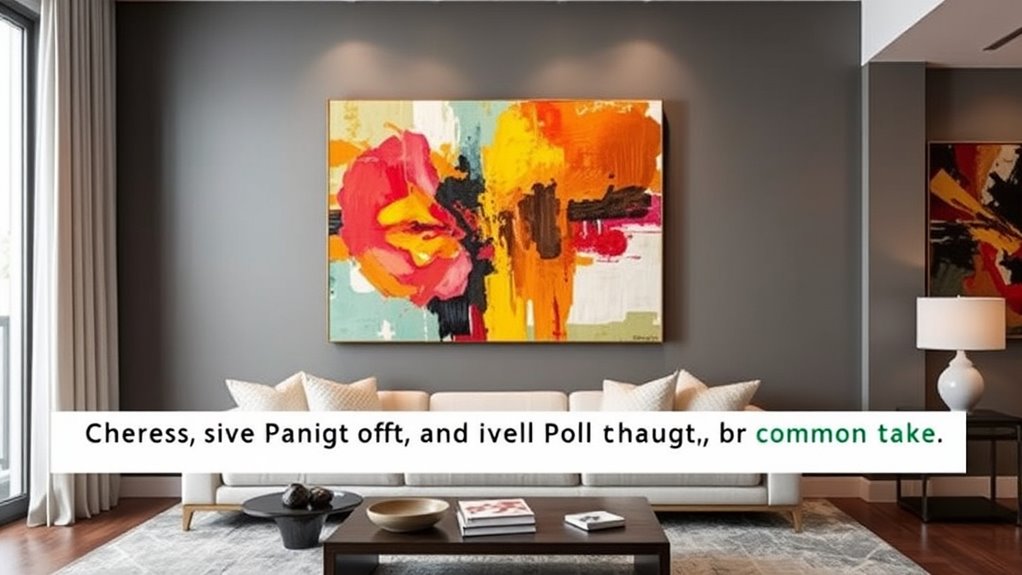
One common mistake to avoid is placing artwork too high or too low on the wall, which can disrupt the room’s visual balance. When art is hung at the wrong height, it can make your space feel awkward or unharmonious. To prevent this, watch out for these mistakes:
- Hanging art above furniture without considering proportional height.
- Ignoring eye-level alignment, which creates visual discomfort.
- Overcrowding artwork on small walls, leading to clutter.
- Using inconsistent spacing between pieces in a gallery wall.
Frequently Asked Questions
How Do I Choose Wall Art Size for Small Rooms?
When choosing wall art size for small rooms, you should aim for pieces that complement the space without overwhelming it. Measure your wall area first, then select art that’s proportionate—generally, artwork that’s about two-thirds the width of your furniture works well. Opt for a single large piece or a small gallery wall to create visual interest without clutter. Keep balance and simplicity in mind to make the room feel open and inviting.
What Tools Are Best for Precise Wall Art Placement?
Think of your tools as your guiding stars in the night sky of decor. A level is your compass, ensuring your art hangs straight and true. A painter’s tape acts like a gentle whisper, marking perfect spots without damage. A tape measure is your steady heartbeat, providing precise measurements. Together, these tools help you navigate the art placement journey, turning your wall into a balanced masterpiece with confidence and ease.
How Can I Adapt Hanging Height for Uneven Walls?
When hanging art on uneven walls, you should focus on eye level as your guide. Measure from the lowest point of the wall and adjust so the center of your artwork aligns with your preferred height. Use a level or a laser tool to guarantee straightness, and consider shimming the frame if needed. This approach helps create a balanced, visually appealing display despite the wall’s irregular surface.
Should Art Be Hung Above or Below Furniture for Best Effect?
They say “a picture is worth a thousand words,” and the right placement makes all the difference. Generally, you should hang art about 4-6 inches above furniture to create a cohesive look. If the piece is large, consider hanging it slightly lower for balance. When in doubt, trust your eye—aim for harmony without overcrowding or leaving too much space. Your space, your style!
How Do Lighting Conditions Affect Wall Art Display?
Lighting conditions play a vital role in how your wall art looks. Bright, natural light highlights colors and details, making your art pop. Dim or uneven lighting can cast shadows or dull the piece’s vibrancy. To enhance your display, position lighting thoughtfully—use spotlights or wall-mounted fixtures to illuminate the artwork evenly, avoiding glare or reflections. Adjusting lighting guarantees your art always looks its best, no matter the time of day.
Conclusion
By mastering the art of hanging wall décor, you turn blank walls into canvases of expression. Think of your space as a symphony where each piece plays its part at just the right height, creating harmony and flow. When you follow these guidelines, your walls become poetry—speaking volumes without a single word. So, trust your eye, embrace the rhythm, and let your walls tell a story that’s uniquely yours.
